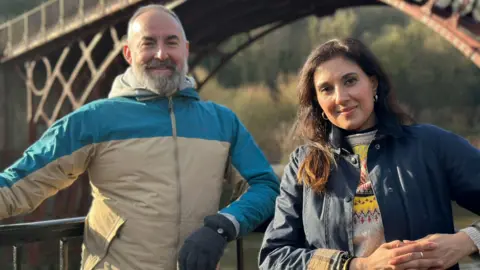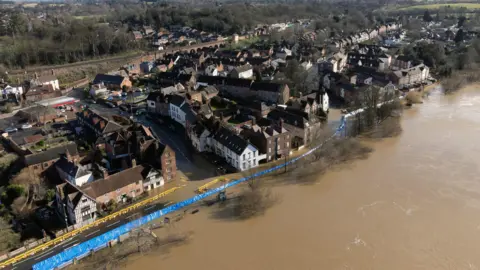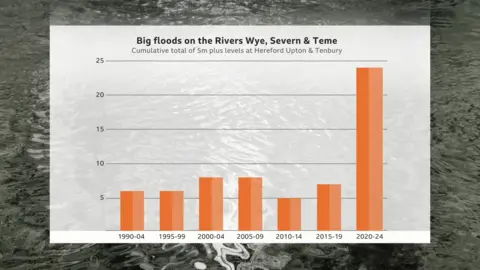Climate change review reveals flooding trend
 BBC
BBCAfter a winter in which large parts of the West Midlands have again suffered from the effects of flooding, Midlands Today is running a special programme on Wednesday looking at how communities and businesses have been affected - and what the future could hold:
Twenty-five years ago, as a young environment correspondent, I joined forces with weather presenter Shefali Oza to look at what climate change might mean for the West Midlands.
A quarter of a century on, we have dipped back into the archive to see how things turned out and look ahead to what the next 25 years could bring.
The most dramatic change was clearly in rainfall and the flooding it caused.
But flooding is not something which that very first climate change piece in 2000 even touched on.
Instead it focused on the evidence for climate change that was all around us and that any viewer could go out and look for.
Simple nature markers like when frogs started spawning or when primroses appeared in a Worcester wood, with all of them getting earlier and earlier in the year.
Because back in the 90s, there was still a chunk of the audience who would call or send me letters saying climate change was not a real thing or that the climate had always changed and it was not anything to do with us.
That first report is an attempt to clearly lay out the evidence to explain what was happening.
While nature is continuing to deal with the warming climate in the Midlands, it is the impact of flooding that has really changed so many lives.
Looking back through the archive of the flood reporting I have done and the weather forecasts Shefali Oza has put together, you can step back and see very clear trends emerging.
Take flooding on three major rivers in the region - the Severn, Wye and Teme.
We can plot out when levels breached 5m.
When I did that first climate change report we saw five such events in a five-year period.
In the last few years we have seen five times as many.
It is no wonder when we looked through the archives you seem to find Shefali announcing the highest recorded river levels or wettest winter since records began, almost every year.
 PA Media
PA MediaA warmer atmosphere can hold more water and it is likely to dump much more of it on one spot. That is why the type of flooding we are seeing is also changing in the Midlands.
Since my first report on climate change, we have spent millions of pounds on our most vulnerable riverside communities, protecting them with flood defences.
Sadly that is likely only a temporary reprieve.
But this warmer atmosphere filled with water puts any property at risk, even if it is not by a river.
Massive, violent dumps of rain could be experienced by any of us at pretty much any time.
That small brook that looks so pretty can rapidly swell, burst its banks and cause chaos - or a city centre can be hit with so much rain at once the drains are overwhelmed and homes and businesses inundated.
As this trend continues, those riverside flood defences will eventually be overwhelmed too.
That is why experts say one in four homes is at future risk of flood damage.
But the situation is not hopeless.
Compared to that first report 25 years ago, people accept the realities of climate change and today we can see what that means for us at the sharp end.

Tackling climate change means looking at how often we fly on holiday or how much we drive our cars.
Insulating our homes and looking at technology like heat pumps and solar panels.
The issue needs councils to make it safer and easier to get around without a car.
At a global level, it is about governments and big corporations and how they treat the planet.
Twenty-five years ago I do not think I could have predicted just how dramatic the impact of climate change would be in the Midlands.
But looking forwards, we can clearly see what is going to happen next and we all know what we have to do to try and change what is coming.
You can watch the full BBC Midland Today special programme from 18:30 GMT on BBC One.
Follow BBC Hereford & Worcester on BBC Sounds, Facebook, X and Instagram.
